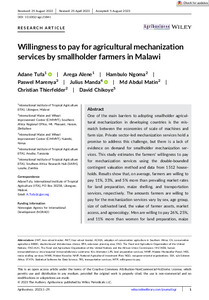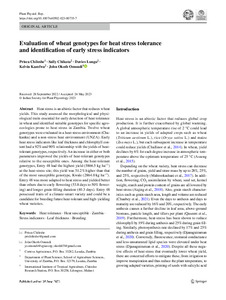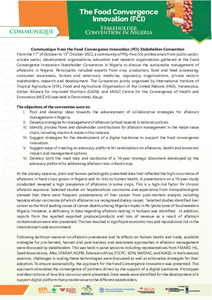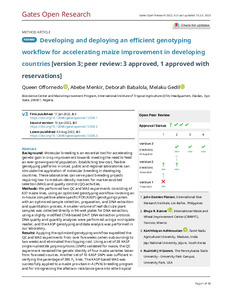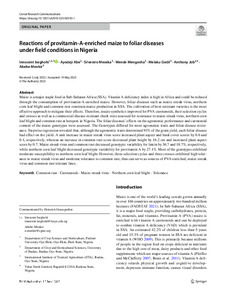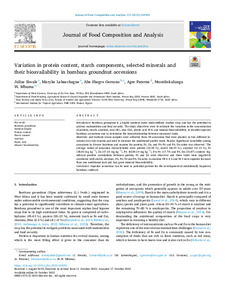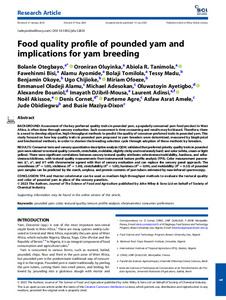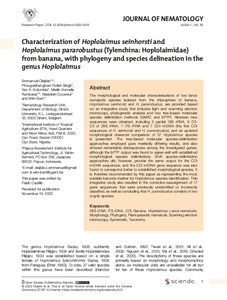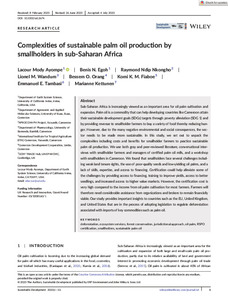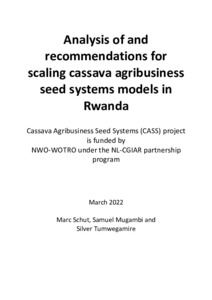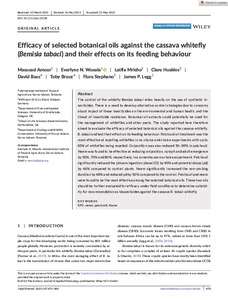Welcome to the International Institute of Tropical Agriculture Research Repository
IITA Bibliography System: Recent submissions
Now showing items 381-400 of 8094
-
Performance and stability of improved cassava (Manihot esculenta Crantz) clones in demand creation trials in Nigeria
(2023-08-02)Cassava fresh root yield and dry matter content constitute major determinants of demand by end-users. Increased demand for the seeds of improved varieties will facilitate the development of a sustainable seed system. However, for wide acceptability, there is a need to continuously evaluate candidate varieties for stability across different agroecological zones. Participatory Demand Creation Trials (DCTs) were established to evaluate cassava varieties with farmers and processors utilizing the best ... -
Willingness to pay for agricultural mechanization services by smallholder farmers in Malawi
(2023-08-17)One of the main barriers to adopting smallholder agricultural mechanization in developing countries is the mismatch between the economies of scale of machines and farm size. Private sector-led mechanization services hold a promise to address this challenge, but there is a lack of evidence on demand for smallholder mechanization services. This study estimates the farmers' willingness to pay for mechanization services using the double-bounded contingent valuation method and data from 1512 households. ... -
EpiCass and CassavaNet4Dev advanced bioinformatics workshop
(2023-06-08)EpiCass and CassavaNet4Dev are collaborative projects funded by the Swedish Research Council between the Swedish University of Agriculture (SLU) and the International Institute of Tropical Agriculture (IITA). The projects aim to investigate the influence of epigenetic changes on agricultural traits such as yield and virus resistance while also providing African students and researchers with advanced bioinformatics training and opportunities to participate in big data analysis events. The first ... -
Evaluation of wheat genotypes for heat stress tolerance and identification of early stress indicators
(2023-06-30)Heat stress is an abiotic factor that reduces wheat yields. This study assessed the morphological and physiological traits essential for early detection of heat tolerance in wheat and identified suitable genotypes for specific agro-ecologies prone to heat stress in Zambia. Twelve wheat genotypes were evaluated in a heat-stress environment (Chakanka) and a non-stress heat environment (UNZA). Early heat stress indicators like leaf thickness and chlorophyll content had a 92% and 90% relationship with ... -
Communique from the Food Convergence Innovation (FCI) stakeholder convention
(IInternational Institute of Tropical Agriculture, 2023) -
Collection and characterization of cassava germplasm in Comoros
(2023-06-15)In Comoros, cassava plays a major food security role, however yields are low as few modern cultivars are grown. Prior to the introduction of new cultivars, and as a germplasm resource for breeders, germplasm collection missions were undertaken in the three largest islands; Ngazidja, Ndzouani and Mwali; and associated farmer knowledge documented. Cassava landraces were collected from 34 farms, and 17 key informant interviews conducted. Stakes of 79 collected landraces were planted for agro-morphological ... -
Socioeconomic effects of Oyo state government COVID-19 palliatives on tomato smallholder farmers
(2023-07)This study interviewed 197 farmers that benefitted from the government palliative in the form of tomato farm inputs to help farmers contain the negative effects of COVID-19 of hunger, food insecurity, and poverty. Demographic features show that the average family size was 6, average age of the beneficiaries was 43, gender of the household heads shows that the beneficiaries have 67% males and 33% females. Production features show that 28% of the tomato farmers intercropped their tomato with other ... -
Developing and deploying an efficient genotyping workflow for accelerating maize improvement in developing countries
(2022-08-03)Background: Molecular breeding is an essential tool for accelerating genetic gain in crop improvement towards meeting the need to feed an ever-growing world population. Establishing low-cost, flexible genotyping platforms in small, public and regional laboratories can stimulate the application of molecular breeding in developing countries. These laboratories can serve plant breeding projects requiring low- to medium-density markers for marker-assisted selection (MAS) and quality control (QC) ... -
Reactions of provitamin-A-enriched maize to foliar diseases under field conditions in Nigeria
(2023-07-17)Maize is a major staple food in Sub-Saharan Africa (SSA). Vitamin A deficiency index is high in Africa and could be reduced through the consumption of provitamin-A-enriched maize. However, foliar diseases such as maize streak virus, northern corn leaf blight and common rust constrain maize production in SSA. The cultivation of host-resistant varieties is the most effective approach to mitigate their effects. Therefore, maize synthetics improved for PVA carotenoids, their selection cycles and crosses ... -
Variation in protein content, starch components, selected minerals and their bioavailability in bambara groundnut accessions
(2023-01)Introduction Bambara groundnut is a highly nutrient dense underutilized orphan crop, and has the potential to address malnutrition and food security. The study objectives were to estimate the variation in the concentration of protein, starch, amylose, iron (Fe), zinc (Zn), phytic acid (PA) and mineral bioavailability, to identify superior bambara accessions and to determine the interrelationship between measured traits. Materials and methods: Grain samples were collected from 59 accessions that ... -
Food quality profile of pounded yam and implications for yam breeding
(2023-07-13)BACKGROUND Assessment of the key preferred quality traits in pounded yam, a popularly consumed yam food product in West Africa, is often done through sensory evaluation. Such assessment is time-consuming and results may be biased. Therefore, there is a need to develop objective, high-throughput methods to predict the quality of consumer-preferred traits in pounded yam. This study focused on how key quality traits in pounded yam proposed to yam breeders were determined, measured by biophysical and ... -
The BananaTainer: a high throughput phenotyping installation to explore Musa's growth potential in the east African highlands
(2023)The East African highlands, a densely populated area in the African Great Lakes region, are located at high altitudes (900-2000 m a.s.l.) and characterized by relatively low average temperatures (17-25°C). Banana (Musa spp.) is an important component of its production landscape, contributing in Uganda to up to 80% of the caloric intake. However, above 1500 m a.s.l. the relatively low ambient temperatures slow down the production and the on-farm diversity decreases. Although enhanced on-farm diversity ... -
Measuring women's empowerment in agriculture: innovations and evidence
(2023-09)This paper addresses women's empowerment in agriculture, innovations in its measurement, and emerging evidence. We discuss the evolution of the conceptualization and measurement of women's empowerment and gender equality since 2010. Using a gender and food systems framework and a standardized measure of women's empowerment, the Women's Empowerment in Agriculture Index (WEAI), we review the evidence on “what works” to empower women based on impact evaluations of a portfolio of 11 agricultural ... -
Association mapping in multiple yam species (Dioscorea spp.) of quantitative trait loci for yield-related traits
(2023-07-11)Background Yam (Dioscorea spp.) is multiple species with various ploidy levels and is considered as a cash crop in many producing areas. Phenotypic selection in yam improvement is a lengthy procedure. However, marker-assisted selection has proven to reduce the breeding cycle with enhanced selection efficiency. Methodology In this study, a panel of 182 yam accessions distributed across six yam species were assessed for diversity and marker-traits association study using SNP markers generated from ... -
Characterization of Hoplolaimus seinhorsti and Hoplolaimus pararobustus (Tylenchina: Hoplolaimidae) from banana, with phylogeny and species delineation in the genus Hoplolaimus
(2023-05-23)The morphological and molecular characterisations of two lance nematode species isolated from the rhizosphere of banana, Hoplolaimus seinhorsti and H. pararobustus, are provided based on an integrative study that includes light and scanning electron microscopy, phylogenetic analysis and two tree-based molecular species delimitation methods (GMYC and bPTP). Nineteen new sequences were obtained, including 5 partial 18S rRNA, 6 D2-D3 of 28S rRNA, 1 ITS rRNA and 7 COI mtDNA (the first COI sequences ... -
Complexities of sustainable palm oil production by smallholders in sub-Saharan Africa
(2023-07-17)Sub-Saharan Africa is increasingly viewed as an important area for oil palm cultivation and expansion. Palm oil is a commodity that can help developing countries like Cameroon attain their sustainable development goals (SDGs) targets through poverty alleviation (SDG 1) and by providing revenue to smallholder farmers to buy a variety of food thereby reducing hunger. However, due to the many negative environmental and social consequences, the sector needs to be made more sustainable. In this study, ... -
Analysis of and recommendations for scaling cassava agribusiness seed systems models in Rwanda
(Cassava Agribusiness Seed Systems, 2022-03)The objective of this study was to analyze the scalability of the cassava seed agribusiness models that have been supported under the CASS project in Rwanda. Phone interviews with key-informants formed the basis for analyzing the agribusiness cases. The study presents general conclusions, bottlenecks and recommendations for further development and scaling of cassava agribusiness seed models in Rwanda. General conclusions The key-informant interviews allowed us to draw the following conclusions: ... -
Status of yam (Dioscorea spp.) in the Democratic Republic of Congo
(2023-07-10)Yam is an important tuber crop with enormous potential to enhance rural sustenance and livelihood in DRC. However, studies to enhance its genetic improvement are very far from sufficient with only a handful of information available on the crop. Yam has been treated as an orphan crop compared to contemporary crops such as cassava and sweet potato which have adapted to different cropping systems and become widespread in production. The lack of research attention to address the major production ... -
Efficacy of selected botanical oils against the cassava whitefly (Bemisia tabaci) and their effects on its feeding behaviour
(2023-08)The control of the whitefly Bemisia tabaci relies heavily on the use of synthetic insecticides. There is a need to develop alternative control strategies due to concerns about impact of these insecticides on the environmental and human health, and the threat of insecticide resistance. Botanical oil extracts could potentially be used for the management of whiteflies and other pests. The study reported here therefore aimed to evaluate the efficacy of selected botanical oils against the cassava ...


